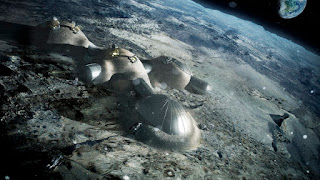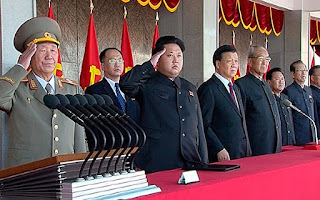The European, Chinese and America efforts to Deepening Human Footprint in Outer Space
The
European, Chinese and America efforts to Deepening Human Footprint in Outer
Space
By E. Stanley Ukeni
In a promising move that would
further cement the human footprint in the near-outer space, officials of the
European Space Agency (ESA) and those of the China National Space
Administration (CNSA) have initiated dialogue aimed at establishing modalities
for a possible partnership in creating a lunar human outpost in the next ten
years.
The initial public hint of this
collaborative talk for a joint lunar base initiative was by the Secretary
General of China’s Space Agency, Tian Yulong, on Chinese State media on
Wednesday, April 26, 2017.
It should be noted that the
Chinese space initiative has made tremendous advancement in the past two
decade. In fact, CSNA has made quantum leaps in its space exploration capabilities
in recent years—enough to get the attention of the European Space Agency.
CNSA and ESA has been engaged
collaborative partnerships since 2003—after Yang Liwei’s successful manned
mission to space. For instance, it was a joint effort by the two Space agencies
that saw the launching of the Double Star Satellite in July of 2004—a
scientific endeavor, described by the agencies as a project that’s aimed at
‘investigating global physical process in Earth’s magnetic environment and its
response to solar disturbances’.
On Thursday, April 20, 2017,
the Chinese Space Agency launched its first cargo spacecraft—a major step in
the nation’s stated objective of establishing its own permanent manned space
station in 2022. The Tianzhou-1 cargo
resupply spacecraft blasted-off early evening on a Long March-7 Y2 rocket from
the Wenchang Satellite Launch Center in the southern island province of Hainan.
The Chinese President Xi
Jinping has, in recent years, given increased priority to advancing the
country’s space program as a means of strengthening its national security. The
United States’ Defense Department has accused the Chinese government of pursing
subversive space-based initiatives aimed at disrupting or destroying the space
assets of other nations in the event of war—siting the Chinese successful
testing and deployment of anti-satellite missiles as prove. However, the Chinese insist that its space
program is for peaceful purposes only.
The spokesman for the European
Space Agency, Pal Hvistendahl, further confirmed, on Wednesday, that the two
agencies were indeed in talks for collaborative Space related projects.
In a statement regarding the
possible collaborative efforts being discussed, Hvistendahl stated that, “The
Chinese have a very ambitious moon program in space… We recognize that to
explore Space for peaceful purposes, we need international cooperation.
On his own part, the Director
General of the twenty-two countries member ESA, Johann-Dietrich Woerner, dubbed
the proposed lunar human outpost as “Moon Village”. He suggested that the moon village could be a
potential international launching station for future Martian human Space
mission, and perhaps an infrastructure for future space tourism—or even
commercial lunar mining.
One major spacefaring country
that that will not be participating in the collaborative project is the United
States—this is because U.S laws bars NASA from participating in any
collaborative research initiatives relating to space with Chinese State
institutions or employees.
This law, enshrined in a 2011
Congressional Act and signed into law by President Obama https://www.gpo.gov/fdsys/pkg/PLAW-112publ55/html/PLAW-112publ55.htm, states in principle, that NASA employees and contractors may
not, “develop, design, plan, promulgate, implement, or execute a bilateral
policy, order, or contract of any kind to participate, collaborate, or
coordinate bilaterally in any way with China.”
The United States is engaged in
its own independent lunar space colony initiative. President Donald Trump has
recently tasked NASA to refocus efforts at sending humans to the moon within
three years—as opposed to initially venturing deeper into outer space.
On Tuesday, March 21st
2017, President Trump singed a new $19.5 billion NASA authorization bill—the
first such funding authorization bill for the U.S. space agency in seven years.
U.S. Vice President, Pence, said at the bill signing that he will be heading a
re-instituted National Space Council—an advisory board that serves as an
intermediary between NASA and the U.S. Executive Branch of government.
I should add here that despite
impressive technological advancements made by the Chinese in recent years, in
its space program—in the areas of military, commercial and scientific
innovation, the United States and Russia are still leaps ahead of the
country.
It’s not particularly
interesting to that the Chinese Space Program have not attained parity with
those of the Americans and the Russians. What’s important to me is that the
world is taking progressive steps towards establishing a permanent human
outpost in an alien world.
I feel confident that humanity
will, within three decades, establish a thriving village outpost in a new earth—somewhere
in outer-space. I boldly say this because I believe that this is the destiny of
humankind. It is our collective birthright conquer this next frontier—our
divine heritage, if you will.
Authored by E. Stanley Ukeni, ©
2017. All Rights Reserved. This material and other articles or stories posted
on this blog site may not be reproduced, published, broadcast, rewritten or
redistributed, in whole or in part, without prior expressed written permission from
the author, E. Stanley Ukeni.
You are invited to follow E.
Stanley Ukeni on twitter at; @EzStan . You’re equally invited to follow him on
google+. Oh yeah, don’t forget to subscribe to this blog Site. Thanks.
Photo Credits: NASA; ESA; CNSA









Comments
Post a Comment